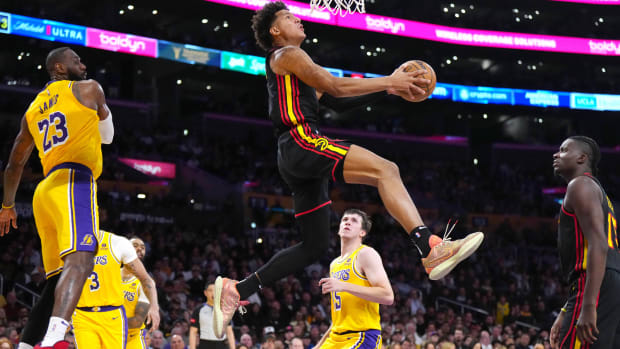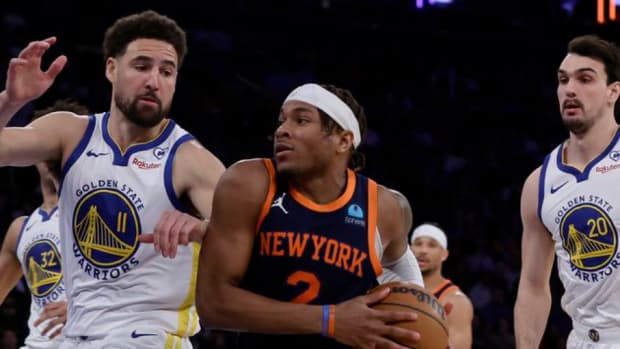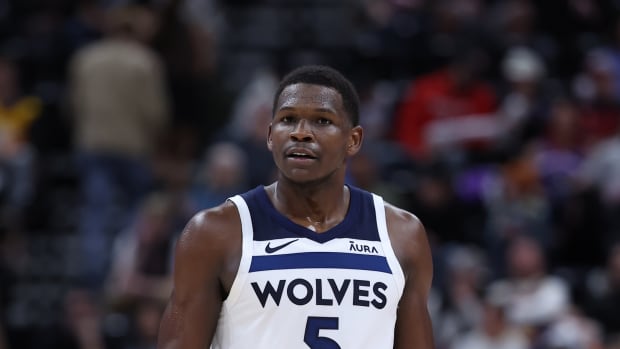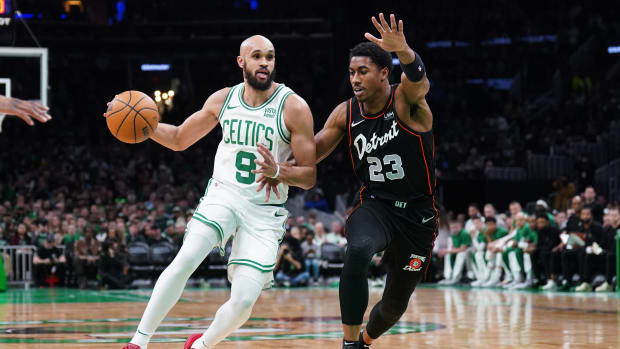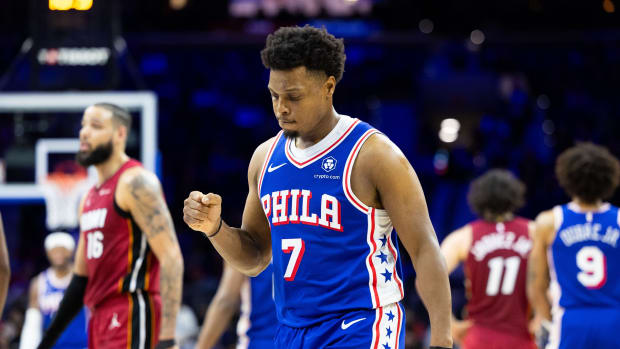Last Night on 'The Last Dance': Episodes 3 & 4
A couple of years after the dipsomaniacal screenwriter played by Nic Cage could not bring himself to leave Las Vegas, Dennis Rodman was going through the same thing. With the reluctant blessing of coach Phil Jackson, Rodman had decamped to Vegas in mid-January 1998 while his Bulls teammates were doing other things. Like, you know, playing basketball.
So did the creative forces behind The Last Dance fashion much of the central tension for Sunday night’s two-episode doubleheader. Jackson had given Rodman a 48-hour freedom window and away ticks the hours, a cinematic version of the 24-second clock. It was a wise decision to turn the spotlight on Rodman; no doubt, many forgot exactly what transpired when the Worm was granted his sybaritic version of load management. Judging by the shots-all-around snippets of Rodman’s Carmen Electra-charged whirlwind that were captured in Vegas—spoiler alert: His vacay clocked in at 80-plus hours—load management was not much of a concern when he was on the Strip.
Indeed, Episodes 3 and 4 of the much-watched pandemic special were almost—emphasis on almost—as much about Rodman as they were Jordan. We’re reminded once again the importance of what Jordan would call “my supporting cast.” (Little did he know when he blithely tossed out that term in the ’80s and ’90s that it would become literal truth on film.) With 10 hours to fill over five weeks, even a documentary about a genius like Mozart would need a few Salieris, and Rodman—a cross-dressing, rebounding fool with a hairstyle resembling the inside of a Petri dish—is as intriguing a Salieri as one could find.
Several other threads unspool across these two one-hour episodes:
- A deconstruction of the Shot, Jordan’s 1989 buzzer-beating, double-clutching jumper that still haunts the dreams of the ’80s Cavaliers. Ron Harper, later a Bulls mainstay during their second three-peat, claims that history would be different had he, not Craig Ehlo, been tasked with defending Jordan on the play. And Jordan agrees that Harper played him tougher. Actually, the Cavalier from whom Jordan escaped first was the doubling Larry Nance; Ehlo eventually got back in front of Jordan, though not snugly enough to stop him.
- A brief look—it could’ve been longer—at Jackson’s unconventional upbringing, during which the high winds of Great Falls, Mont., and the high faith of his fundamentalist parents swept over him. That combination produced a deep-thinking maverick (a Jackson autobio title) who swung elbows with the Knicks and later, as a coach, had to climb into the heads of personalities like Jordan, Rodman, Shaquille O’Neal and Kobe Bryant, not to mention various unknown members of the CBA’s Albany Patroons and the Piratas de Quebradillas of the Puerto Rican Super League, early stops on the Jackson coaching caravan. Director Jason Hehir chose Cream’s psychedelic-sounding “I Feel Free” as a backdrop to clips from Jackson’s time with the Knicks, and it says a lot about the coach that the soundtrack is apt.
- A look at the “Scottie migraine game”—Game 7 of the 1990 Eastern Conference Finals, when Pippen, weakened by what he said was a devastating headache, was a nullity and the Pistons ran all over the Bulls, 93-74. Jordan is asked about it, and his smirk is as wide as Rick Mahorn’s backside. He will never get over it. He will never be able to not smirk. The documentary will later cover the “flu game”—what franchise has two playoff games named after maladies?—when Jordan, despite being sweatingly sick, scored 38 points in Game 5 of the ’97 Finals, a 90-88 win over the Jazz. As much as he praises Pippen throughout The Last Dance, Jordan will eternally measure Pippen’s ’90 performance against his own eight long seasons later. He just can’t help himself.
- A full treatment of the Triangle offense, including a 1960 clip of then Kansas State coach Tex Winter drawing the scheme up on a blackboard. To triangularists, this is tantamount to capturing video of Thomas Jefferson, quill in hand, asking the assembled in Philadelphia, “What say you of this phrase: ‘We hold these truths to be self-evident …’ ” The Triangle also leads to a few melancholy moments with Doug Collins, who was pushed aside as Chicago’s coach in the summer of 1989 because he would not adopt the Triangle, preferring the Let’s give it to Michael option above all. Collins, one of the all-time good guys, is rehabbing from serious back surgery, and when I contacted him he did not want to comment publicly about the doc. But in his Last Dance screen time he is obviously reluctant to express his true feelings. Thirty years later, he’s still angry and hurt he did not get a chance to go the distance with Jordan, with whom he shared a deep bond.
And, as always, there is Michael—master of his domain, indomitable, imperious, intimidating even when seated, rheumy eyes lighting up when a subject wanders into his anger zone. “I didn’t want Bill Cartwright to have the ball with five seconds left!” says Jordan, speaking about the early implementation of the Triangle offense. “That’s not equal-opportunity offense. That’s f---ing bulls---.”
So comfortable is Jordan in that anonymous, airy mansion that I’ve begun to think of it as a mystical place, Michael Manor, where every once in a while a tuxedoed butler emerges and shouts, “Nothing but the finest kabobs and freshest of fruits for Mr. Jordan! And refill whatever the hell that brown liquid is in his glass!”
Hehir even submits to a full minute and 39 seconds (I clocked it) of straight-up Jordan highlight porn, which, amid the shots of Rodman doing shots and Scottie Agonistes detailing his contract complaints, serves to remind us of the central reason we’re drawn to this story: Jordan the basketball player. As he skies over 7' 7" Manute Bol; one-hand stuffs over 7' 1" Tree Rollins; absorbs contact and makes a layup almost facing backward against Patrick Ewing; goes from one side of the basket to the other, through and between three Hawks defenders—I’m summarizing here—we marvel both at how he got those shots off and how in the hell they went in the basket.
* * *
The first time I became aware of Rodman was at a Pistons practice in 1986, his rookie year. “Hey, Dennis, come here,” coach Chuck Daly called to him. Daly motioned to a few assembled reporters. “Show ‘em the trick.” Rodman picked up a basketball at midcourt, whipped it around his back and banged it off the backboard—very near the rim—47 feet away. “He does stuff like that all the time,” Daly said. “Freakish athlete.”
The Pistons’ hierarchy, which is to say Isiah Thomas and Bill Laimbeer, treated Rodman rather like a kid brother. They would chide him about his gung-ho attitude and his propensity to launch himself, missile-like, after loose balls that were heading out of bounds. Rodman didn’t see spectators as much as he saw potential mosh pits, and he was still self-launching in 1998, at age 37, as Sunday’s episodes demonstrate.
The Worm turned and became less of a novelty item when, despite averaging only about nine points per game, he emerged as a significant figure in the Pistons’ back-to-back championships, in 1989 and ’90. He guarded everybody with a frenetic chest-out hauteur, his prancing, almost equine running style exuding pride (if you were a Bad Boys fan) or arrogance (if you were not). There was a studied MO about the Pistons’ physicality—they knocked MJ down but they did it according to the Jordan Rules—but Rodman was the screw-loose wild card, the reminder that things could get really crazy. Hey, he played his NAIA college ball for the Southeastern Oklahoma State Savages.
Ergo, many observers were surprised when Rodman joined the kingly Bulls in 1995, acquired via trade with the Spurs at the urging of Chicago’s assistant general manager, Jim Stack. Rodman seemed to spell trouble, and that’s trouble with a T, which rhymes with V, and that stands for Vegas. (It also rhymes with C, which stands for Carmen. Note to self: Consult Google for update on current Electra sitch.)
But it also stands for D, and Rodman knew his role from the moment he arrived in Chicago. Defend and rebound. Though his flame flickered from time to time—one of those times was early in the 1997-98 season, when Pippen was recovering from surgery and Jordan most needed him—Rodman at his best was a relentless, sweating Stakhanovite, chasing down caroms, tip-tip-tipping it to himself, the league’s leading rebounder an astounding seven times in a row from ’92 through ’98. He was also a student of the game, “one of the smartest players I ever played with,” as Jordan says, and Rodman talks at length about rebounding positioning and being able to gauge how the ball would come off the rim depending on who was shooting. (Interestingly, one of Rodman’s chief rebounding rivals at the time, Charles Barkley, took the opposite approach. “Sheeeet!” Barkley would say. “I just went and got the damn ball.”)
I’m glad Rodman had a life after the Bad Boys, because some of those Detroit players are stuck in time, constantly carping that the NBA wanted Jordan to succeed, suggesting the Pistons have been forgotten. “We knew how important to the NBA it was to get Michel to the next level,” John Salley says in Episode 3. “The blueprint was Larry, Magic, now Michael. And all of a sudden there was this little team in Detroit that messed up the whole story. We loved that.” Isiah continues the theme: “We weren’t the pretty team that got invited to the Lakers and Celtics' party.”
But I never understood this. Being the ultimate outsider was exactly what the Bad Boys wanted, so why do they constantly complain about it? A smart, veteran team, the Pistons consciously carved out an identity, then whined about having it. Plus, if the NBA did have a “blueprint” for Jordan to win, it still took him seven seasons to reach the Finals.
Look, Bad Boys. Gather 'round. Your place in this Golden Era/renaissance of the NBA, roughly 1980 to ’98, is safe and secure. With championships in ’89 and ’90, you were the fourth-best franchise, behind the Bulls (six titles), the Lakers (five) and the Celtics (three). You haven’t been forgotten. There’s an entire ESPN documentary about you. You have your own alliterative sobriquet. Enough of the We don’t get enough respect schtick.
Similarly, Isiah seems bound and determined to rationalize away the Pistons walking off the court in 1991 after the Bulls swept them in the Eastern Conference finals. Thomas claims there was a precedent for that sort of thing back then, but Jordan, wandering into the Anger Zone, accurately calls B.S. Thomas points to Larry Bird walking off the court without shaking hands after the Pistons eliminated the Celtcis in 1988—and, indeed, as the video shows, Bird did not stop to shake hands. But I was at that game, and I don’t remember seeing it. Nobody noticed it. It was not a thing. Nobody talked about it in the locker room, though a friendly postgame on-court conversation between Isiah and McHale has been much discussed.
Detroit’s snub was different. It was orchestrated, not a singular display of bad sportsmanship. Video shows Laimbeer suggesting it to Isiah—not the other way around—and Isiah goes along, just as he went along with Rodman’s comment a year earlier that if Bird were black “he’d be just another good guy.” Isiah even had the good sense to look a little sheepish as he passed by the Bulls on the bench. That walkout was a thing, and Isiah’s claim that it was done all the time is undercut by footage of Jordan and the Bulls hanging around to congratulate the Pistons after playoff defeats in previous years. And you know what? I didn’t put the Detroit walkout in my story about that game. You don't see everything. And sometimes events need time to sink in.
As both the doler-out of Jordan Rules punishment and later a Bulls teammate, Rodman has a unique perspective on MJ. His comment from Episode 3 strikes me as one of the most perceptive observations ever made about Jordan, flowing as it does in the distinctive Rodman cadence: “I can compare Michael Jordan to nobody because for him to survive [the beating administered by the Bad Boys] and still maintain that greatness? It’s very unparalleled.” Not just unparalleled. Very unparalleled.
But as the first four episodes of The Last Dance have demonstrated, the NBA of the ’90s was quite different from today’s game—more physical, even nastier. A few young fans—fans brought up in an era when nasty means unfollowing someone on social media—have mentioned this to me. The literal contours of the game haven’t changed, of course, but Jordan, as he wrenches himself free of elbows, arms and bodies, seems to be playing in a confined space, a court where even shooters like John Paxson and Steve Kerr rarely venture out to three-point land.
* * *
So, back to Vegas and Carmen Electra, who, by the way, became Mrs. Dennis Rodman in November 1998. (The couple gave it the matrimonial equivalent of a 10-day contract, breaking up in April ’99.) If the mind boggles at the idea that Jackson allowed Rodman to take a Vegas powder during the season, it boggles almost as much at what Jackson did when Rodman got back. He ordered the team into what Jordan calls an “Indian drill,” in which the last player of a single-file pack has to sprint to get to the front, thus ensuring that a certain aerobic level is maintained. (“I can’t imagine letting a player go to Vegas in the middle of the season,” Rockets coach Mike D’Antoni said when I asked him about it. “But I’ll tell you what else I can’t imagine: having my players do a running drill.”) Like an annoyed eighth-grader, Jordan urged his mates to jog easily, but Rodman wouldn’t go along. When the Worm got the lead, the back runner couldn’t catch him for four laps.
"I had what I called this Hiawatha line on the Berto Center floor," Jackson said, referring to the Bulls' practice facility. (An aficionado of Native American culture who grew up interacting with kids from the Poplar tribe in Montana, Jackson was comfortable with that reference and also frequently uses "Indian" instead of "Native American.") “MJ tried to strike a deal, but I knew Dennis would do what he does—break away from the pack.” Jackson and Rodman had a deep connection beyond their maverick inclinations: When Rodman first noticed the Native American artifacts in Jackson’s office, he told his coach he had a necklace from the Ponca Indian tribe in Oklahoma.
Consider this scenario in its entirety. A player escapes from his team for a four-day Vegas holiday, canoodles with one of the It Girls of the time, misses two games, and when he returns he sabotages his mates in an annoying conditioning drill that was assigned only because he missed practice. In regular life, you call that person a dick. On the 1997-98 Bulls, you call that person Dennis Rodman.
But, then, in those ancient ’90s, practices were harder, not to mention more frequent. Today’s NBA teams rarely even practice during the season, far less practice hard. “Practice was very important to us,” Jackson says. “We believed in staying precise and conditioned. We worked closely with the training staff—a weight program, a conditioning program and a practice format for working on skills and Triangle precision.”
Ah, yes, the sacred Triangle. Jackson returns to it time and time again, and I’ve long thought that his affection for the Triangle went deeper than his viewing it as an effective offensive stratagem. There was—there is—something about him that embraces symbols and totems. And he plugged into the mystery of this geometric shape, the idea of equal distribution on all three sides, the idea that as long as all sides stay strong the triangle is unbreakable. In his emails, Jackson even cuts and pastes a figure of a triangle instead of spelling out the word. I’m not there yet.
Near the end of Episode 4 we take a linear dive through the Bulls’ first championship, in 1991, which includes a clip of general manager Jerry Krause doing an ass-shaking, celebratory boogaloo with Pippen on the team plane. It’s hard to wrest that image from the memory bank, but, hey, it’s nice that Krause had that moment considering how much crap he took from the in crowd of Jordan and Pippen. The Last Dance then pivots back to the ’97-98 season, in which the documentary is grounded.
The Bulls blow a big lead and lose a February game in Utah, the powerhouse in the West, and back in Chicago Krause doubles down on his divisive Phil ain’t coming back and Michael’s gotta know that comments. An ominous voice intones, “Is this the end of the Bulls as we know them?”
R.E.M. reference aside, I call traveling on that pivot. When Utah enters the picture we immediately cut ahead to June, where Jordan shrugs off Bryon Russell and hits a jumper that locks up the second three-peat. We can’t unknow what we know.
Still, The Last Dance isn’t about narrative intrigue. It’s about the journey, and so far we’ve been all over the place—to Wilmington, N.C., for Jordan; to Hamburg, Ark., for Pippen; to Great Falls, Mont., for Jackson; to Vegas for Rodman. And we can always return comfortably to Michael Manor, where the glass of brown goes up and down, as do the passions of the lord and master. I’m confident there is still much to be explored. We’re four hours in, after all, and I don’t know a damn thing about Jud Buechler.
Jack McCallum covered Jordan for years as an SI senior writer and remains a special contributor to the magazine. The author of the New York Times bestseller Dream Team, he is the narrator of the upcoming podcast The Dream Team Tapes, due out May 17. Subscribe here.
More From SI.com
Last Night on The Last Dance: Episodes 1 & 2





































